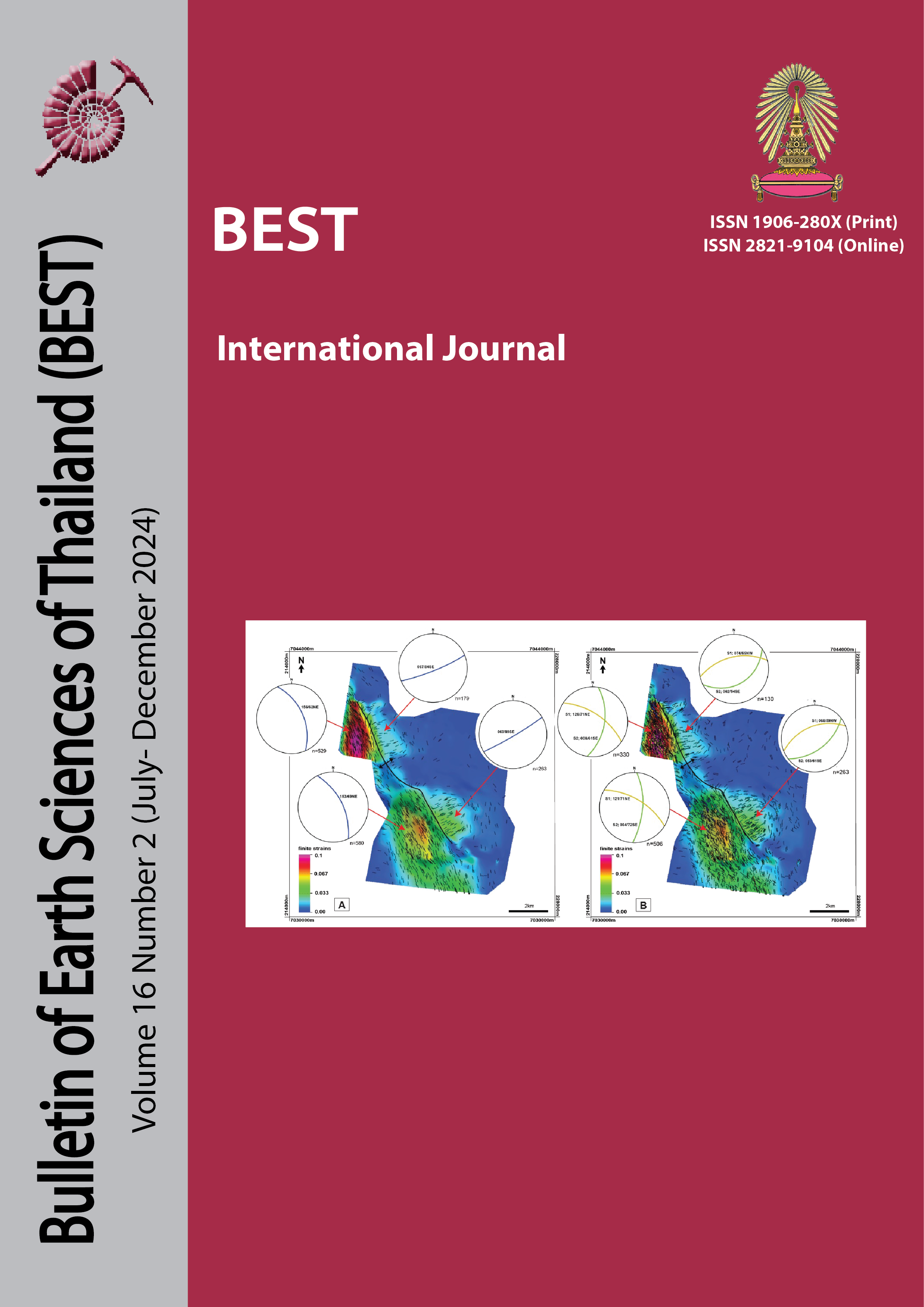Outcrop Analogue for Basement Exploration in Songkhla Basin, Gulf of Thailand
Main Article Content
Abstract
This study focuses on the lithological and structural variations in the pre-Cenozoic rocks of the Songkhla and Phatthalung areas, likely constituting the basement rocks of the offshore Songkhla Basin, where subsurface exploration is limited by seismic resolution. The methodology employed includes field studies and digital outcrop analysis to determine the relationships and patterns of bedding planes, fractures, and folding. Four lithological facies are defined: 1) Sandstone-dominated facies, 2) Shale-dominated facies, 3) Chert facies, and 4) Granite. The fold analysis indicates contraction varying from WNW-ESE to NW-SE. The dominant fracture patterns align with the NW direction, running subparallel to the maximum horizontal stress and perpendicular to the fold axis. Conversely, secondary fracture patterns appear in the NE-SW direction. At the outcrop scale, fracture characterization indicates that open fractures predominantly occur in coarse-grained and poorly sorted sandstone, chert—especially in the forelimb zone—and granite. In contrast, finer sediments and sedimentary rocks adjacent to the granite are typically clay-filled or filled with quartz veins and veinlets. The results are expected to enhance the understanding of the geology at a sub-seismic scale of the pre-Cenozoic fractured basement potential in the Songkhla Basin.
Article Details

This work is licensed under a Creative Commons Attribution-NonCommercial-NoDerivatives 4.0 International License.
Copyright © 2008 Department of Geology, Faculty of Science, Chulalongkorn University. Parts of an article can be photocopied or reproduced without prior written permission from the author(s), but due acknowledgments should be stated or cited accordingly.
References
Charusiri, P., Clark, A. H., Farrar, E., Archibald, D., & Charusiri, B. (1993). Granite belts in Thailand: evidence from the 40Ar/39Ar geochronological and geological syntheses. Journal of Southeast Asian Earth Sciences, 8(1-4), 127-136.
DMR (Department of Mineral Resources of Thailand), 2007. Geological map of Changwat Songkhla, Scale 1:250,000. Geological Survey Division of Mineral Resources of Thailand, Bangkok.
Doust, H., & Sumner, H. S. (2007). Petroleum systems in rift basins–a collective approach in Southeast Asian basins. Petroleum Geoscience, 13(2), 127-144.
Fujikawa, M., Ueno, K., Sardsud, A., Saengsrichan, W., Kamata, Y., & Hisada, K. I. (2005). Early Permian ammonoids from the Kaeng Krachan Group of the Phatthalung-Hat Yai area, southern peninsular Thailand. Journal of Asian Earth Sciences, 24(6), 739-752.
Grant-Mackie, J. A., Sawata, H., Arpornsuwan, S., Arrykul, S., Chutatis, V., & Pungrassami, T. (1980). Some Triassic and associated strata of southern Thailand. Report of Triassic Study Team 1, Prince of Songkla University, Geological Research Project, 9, p. 85.
Gusti, U. K., & Ferguson, A. (2022). Characterization of naturally fractured basement reservoir and its play concept, South Pattani Basin, Gulf of Thailand. Bulletin of the Geological Society of Malaysia, Volume 73, p.105-118.
Kaewkor, C., Watkinson, I. M., & Burgess, P. (2015, November). Structural style and evolution of the Songkhla Basin, western Gulf of Thailand. In Proceedings of the International Conference on Geology Geotechnology and Mineral Resources of Indochina (GEOINDO 2015), Khon Kaen, Thailand.
Kamata, Y., Shirouzu, A., Ueno, K., Sardsud, A., Charoentitirat, T., Charusiri, P., ... & Hisada, K. I.(2014). Late Permian and Early to Middle Triassic radiolarians from the Hat Yai area, southern peninsular Thailand: Implications for the tectonic setting of the eastern margin of the Sibumasu Continental Block and closure timing of the Paleo-Tethys. Marine Micropaleontology, 110, 8-24.
Morley, C.K., Racey, A., (2011). Tertiary stratigraphy. In: Ridd, M.F., Barber, A.J., Crow, M.J.(Eds.), The Geology of Thailand. Geological Society of London Memoir, pp. 273-334 (Chapter 10).
Muenlek, S., Meesook, A., Tongchit, P., Tipdonsab, C., & Skulkeaw, P. Amphoe Betong.
Polachan, S., Pradidtan, S., Tongtaow, C., Janmaha, S., Intarawijitr, K., & Sangsuwan, C. (1991). Development of Cenozoic basins in Thailand. Marine and Petroleum Geology, 8(1), 84-97.
Pongsapich, W., Pisutha-Arnond, V., & Charusiri, P. (1983, September). Reviews of Felsic Plutonic Rocks of Thailand. In Proc. of the Workshop on Stratigraphic Correlation of Thailand and Malaysia (pp. 213-232).
Ridd, M. F. (2013). A Middle Permian–Middle Triassic accretionary complex and a Late Triassic foredeep basin: Forerunners of an Indosinian (Late Triassic) thrust complex in the Thailand–Malaysia border area. Journal of Asian Earth Sciences, 76, 99-114.
Saifulizan, S. S. (2019). Mapping basement and basement faults for prediction of potential basement reservoirs using seismic attributes in Western Basin, Gulf of Thailand. Bulletin of Earth Sciences of Thailand, 11(2), 37-44.
Sashida, K., & Salyapongse, S. (2002). Permian radiolarian faunas from Thailand and their paleogeographic significance. Journal of Asian Earth Sciences, 20(6), 691-701.


